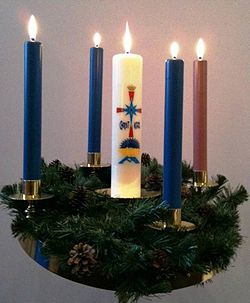| O Come, O Come, Emmanuel | |
|---|---|
 | |
| Native name | Veni, veni, Emmanuel |
| Genre | Hymn |
| Written | 1861 (translated) |
| Text | John Mason Neale, translator |
| Based on | Matthew1:23 |
| Meter | 8.8.8.8. (L.M.) with Refrain |
| Melody | "Bone Jesu dulcis cunctis" (anon., 15th c.) |
| Recording | |
"Veni, Veni Emmanuel", arranged by Peter Zagar for voice and cello | |
"O come, O come, Emmanuel" (Latin: "Veni, veni, Emmanuel") is a Christian hymn for Advent, which is also often published in books of Christmas carols. [1] [2] [3] The text, originally written in Latin, is a metrical paraphrase of the O Antiphons, a series of plainchant antiphons attached to the Magnificat at Vespers over the final days before Christmas. The hymn has its origins over 1,200 years ago in monastic life in the 8th or 9th century. Seven days before Christmas Eve monasteries would sing the “O antiphons” in anticipation of Christmas Eve when the eighth antiphon, “O Virgo virginum” (“O Virgin of virgins”) would be sung before and after Mary's canticle, the Magnificat (Luke 1:46b–55). The Latin metrical form of the hymn was composed as early as the 12th century. [4]
Contents
- The Latin text
- The five-verse Latin text
- The seven-verse Latin text
- English versions of the text
- Texts of the major English translations
- The music
- The "Veni Emmanuel" tune
- Rise to hegemony
- Other tunes
- Musical influence
- See also
- References
- External links
The 1851 translation by John Mason Neale from Hymns Ancient and Modern is the most prominent by far in the English-speaking world, but other English translations also exist. Translations into other modern languages (particularly German) are also in widespread use. While the text may be used with many metrical hymn tunes, it was first combined with its most famous tune, often itself called Veni Emmanuel, in the English-language Hymnal Noted in 1851. Later, the same tune was used with versions of "O come, O come, Emmanuel" in other languages, including Latin.




